Change Management on Employee and Business Performance Report
VerifiedAdded on 2023/01/17
|9
|2999
|77
Report
AI Summary
This report provides a comprehensive literature review on the impact of change management on employee and business performance. It explores various aspects, including the definition of change, the reasons for change failure, and the importance of employee perception. The report discusses the characteristics of change management, the role of information and communication, and the significance of trust in management. It also examines studies on change management in different contexts, such as non-governmental institutions and educational settings. Furthermore, the report highlights the different forms of change (planned and unplanned), the role of change agents, and the importance of strategic management. The analysis covers factors like employee acceptance, communication strategies, and the overall impact on organizational success. The report concludes by emphasizing the need for effective change management to achieve desired outcomes.
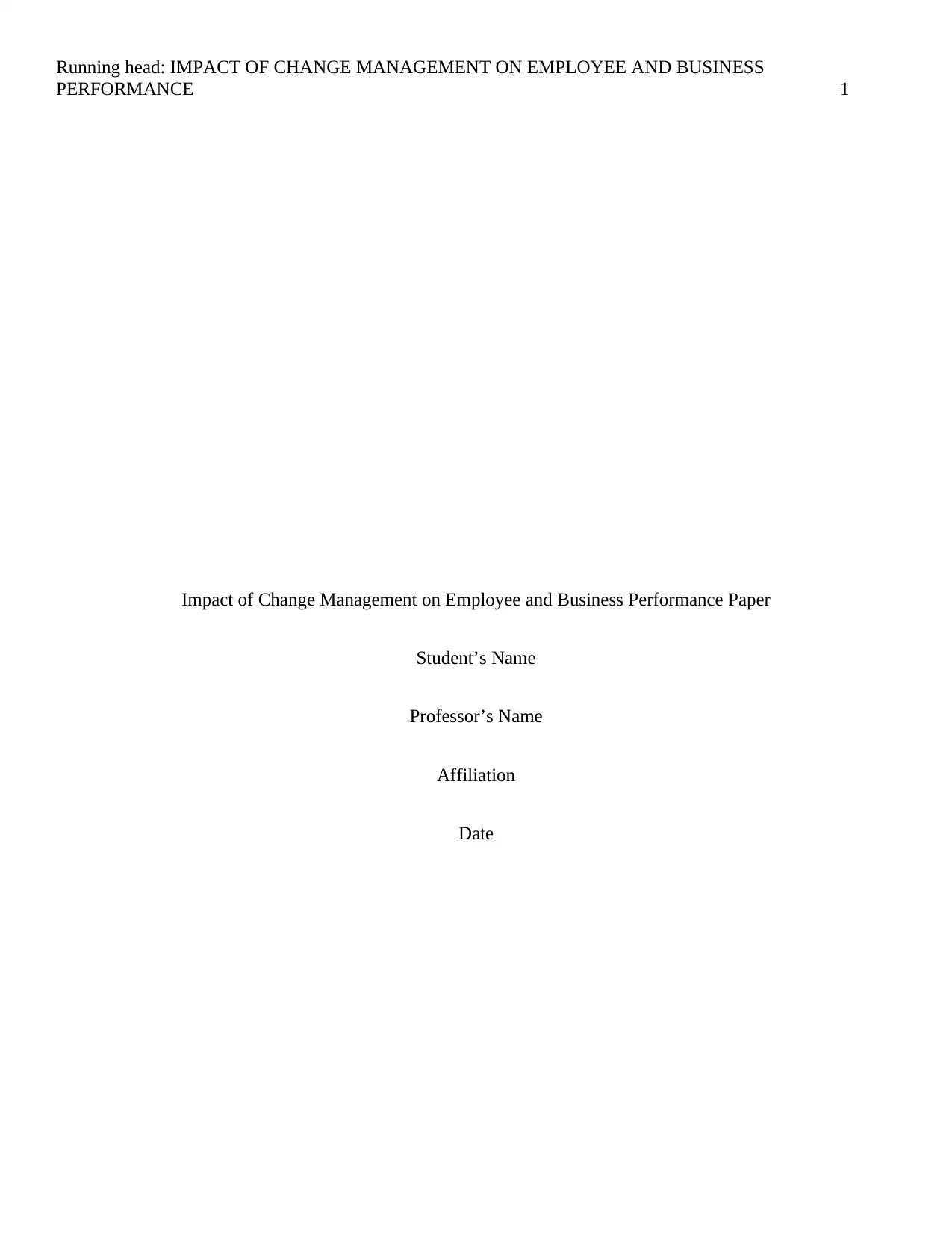
Running head: IMPACT OF CHANGE MANAGEMENT ON EMPLOYEE AND BUSINESS
PERFORMANCE 1
Impact of Change Management on Employee and Business Performance Paper
Student’s Name
Professor’s Name
Affiliation
Date
PERFORMANCE 1
Impact of Change Management on Employee and Business Performance Paper
Student’s Name
Professor’s Name
Affiliation
Date
Paraphrase This Document
Need a fresh take? Get an instant paraphrase of this document with our AI Paraphraser
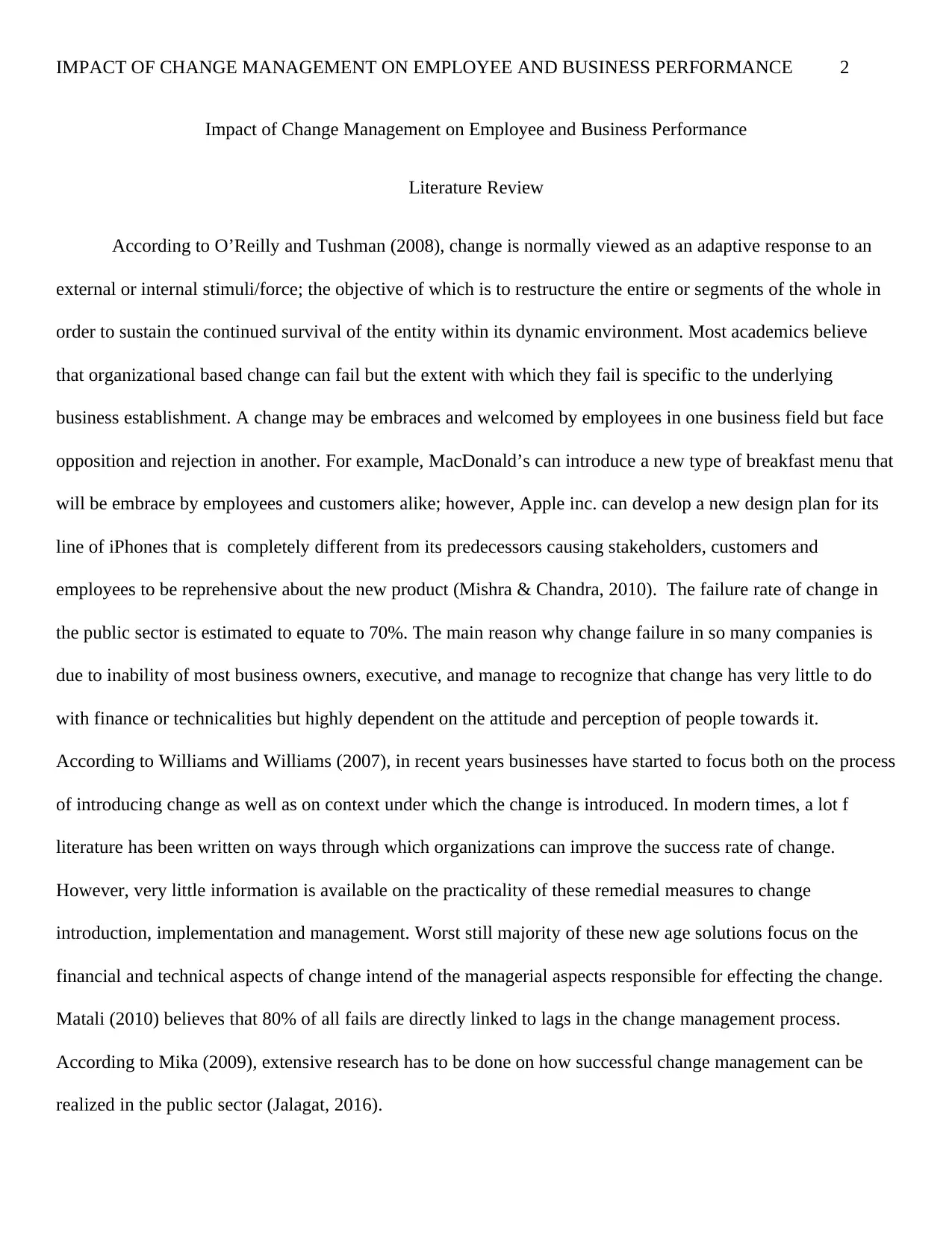
IMPACT OF CHANGE MANAGEMENT ON EMPLOYEE AND BUSINESS PERFORMANCE 2
Impact of Change Management on Employee and Business Performance
Literature Review
According to O’Reilly and Tushman (2008), change is normally viewed as an adaptive response to an
external or internal stimuli/force; the objective of which is to restructure the entire or segments of the whole in
order to sustain the continued survival of the entity within its dynamic environment. Most academics believe
that organizational based change can fail but the extent with which they fail is specific to the underlying
business establishment. A change may be embraces and welcomed by employees in one business field but face
opposition and rejection in another. For example, MacDonald’s can introduce a new type of breakfast menu that
will be embrace by employees and customers alike; however, Apple inc. can develop a new design plan for its
line of iPhones that is completely different from its predecessors causing stakeholders, customers and
employees to be reprehensive about the new product (Mishra & Chandra, 2010). The failure rate of change in
the public sector is estimated to equate to 70%. The main reason why change failure in so many companies is
due to inability of most business owners, executive, and manage to recognize that change has very little to do
with finance or technicalities but highly dependent on the attitude and perception of people towards it.
According to Williams and Williams (2007), in recent years businesses have started to focus both on the process
of introducing change as well as on context under which the change is introduced. In modern times, a lot f
literature has been written on ways through which organizations can improve the success rate of change.
However, very little information is available on the practicality of these remedial measures to change
introduction, implementation and management. Worst still majority of these new age solutions focus on the
financial and technical aspects of change intend of the managerial aspects responsible for effecting the change.
Matali (2010) believes that 80% of all fails are directly linked to lags in the change management process.
According to Mika (2009), extensive research has to be done on how successful change management can be
realized in the public sector (Jalagat, 2016).
Impact of Change Management on Employee and Business Performance
Literature Review
According to O’Reilly and Tushman (2008), change is normally viewed as an adaptive response to an
external or internal stimuli/force; the objective of which is to restructure the entire or segments of the whole in
order to sustain the continued survival of the entity within its dynamic environment. Most academics believe
that organizational based change can fail but the extent with which they fail is specific to the underlying
business establishment. A change may be embraces and welcomed by employees in one business field but face
opposition and rejection in another. For example, MacDonald’s can introduce a new type of breakfast menu that
will be embrace by employees and customers alike; however, Apple inc. can develop a new design plan for its
line of iPhones that is completely different from its predecessors causing stakeholders, customers and
employees to be reprehensive about the new product (Mishra & Chandra, 2010). The failure rate of change in
the public sector is estimated to equate to 70%. The main reason why change failure in so many companies is
due to inability of most business owners, executive, and manage to recognize that change has very little to do
with finance or technicalities but highly dependent on the attitude and perception of people towards it.
According to Williams and Williams (2007), in recent years businesses have started to focus both on the process
of introducing change as well as on context under which the change is introduced. In modern times, a lot f
literature has been written on ways through which organizations can improve the success rate of change.
However, very little information is available on the practicality of these remedial measures to change
introduction, implementation and management. Worst still majority of these new age solutions focus on the
financial and technical aspects of change intend of the managerial aspects responsible for effecting the change.
Matali (2010) believes that 80% of all fails are directly linked to lags in the change management process.
According to Mika (2009), extensive research has to be done on how successful change management can be
realized in the public sector (Jalagat, 2016).
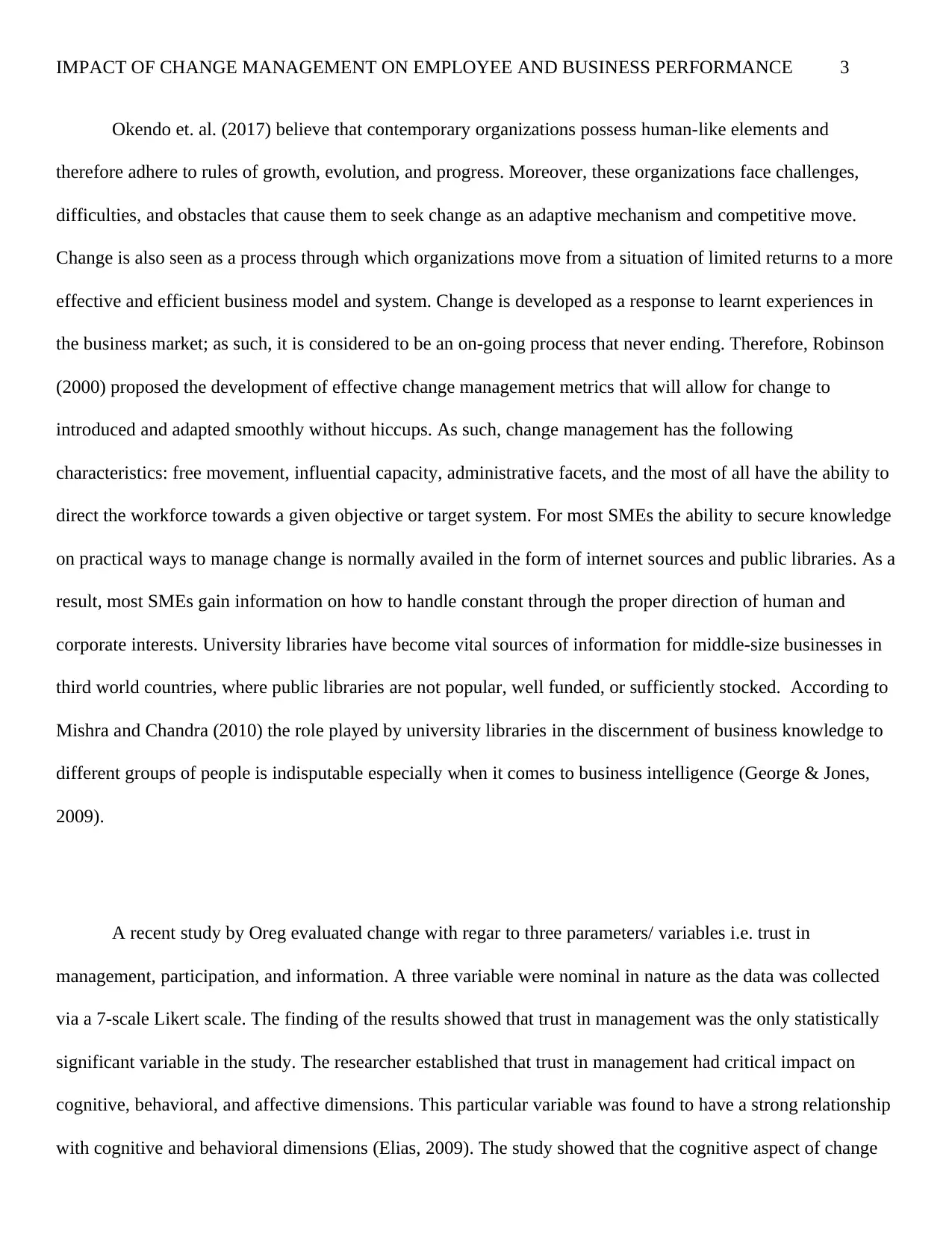
IMPACT OF CHANGE MANAGEMENT ON EMPLOYEE AND BUSINESS PERFORMANCE 3
Okendo et. al. (2017) believe that contemporary organizations possess human-like elements and
therefore adhere to rules of growth, evolution, and progress. Moreover, these organizations face challenges,
difficulties, and obstacles that cause them to seek change as an adaptive mechanism and competitive move.
Change is also seen as a process through which organizations move from a situation of limited returns to a more
effective and efficient business model and system. Change is developed as a response to learnt experiences in
the business market; as such, it is considered to be an on-going process that never ending. Therefore, Robinson
(2000) proposed the development of effective change management metrics that will allow for change to
introduced and adapted smoothly without hiccups. As such, change management has the following
characteristics: free movement, influential capacity, administrative facets, and the most of all have the ability to
direct the workforce towards a given objective or target system. For most SMEs the ability to secure knowledge
on practical ways to manage change is normally availed in the form of internet sources and public libraries. As a
result, most SMEs gain information on how to handle constant through the proper direction of human and
corporate interests. University libraries have become vital sources of information for middle-size businesses in
third world countries, where public libraries are not popular, well funded, or sufficiently stocked. According to
Mishra and Chandra (2010) the role played by university libraries in the discernment of business knowledge to
different groups of people is indisputable especially when it comes to business intelligence (George & Jones,
2009).
A recent study by Oreg evaluated change with regar to three parameters/ variables i.e. trust in
management, participation, and information. A three variable were nominal in nature as the data was collected
via a 7-scale Likert scale. The finding of the results showed that trust in management was the only statistically
significant variable in the study. The researcher established that trust in management had critical impact on
cognitive, behavioral, and affective dimensions. This particular variable was found to have a strong relationship
with cognitive and behavioral dimensions (Elias, 2009). The study showed that the cognitive aspect of change
Okendo et. al. (2017) believe that contemporary organizations possess human-like elements and
therefore adhere to rules of growth, evolution, and progress. Moreover, these organizations face challenges,
difficulties, and obstacles that cause them to seek change as an adaptive mechanism and competitive move.
Change is also seen as a process through which organizations move from a situation of limited returns to a more
effective and efficient business model and system. Change is developed as a response to learnt experiences in
the business market; as such, it is considered to be an on-going process that never ending. Therefore, Robinson
(2000) proposed the development of effective change management metrics that will allow for change to
introduced and adapted smoothly without hiccups. As such, change management has the following
characteristics: free movement, influential capacity, administrative facets, and the most of all have the ability to
direct the workforce towards a given objective or target system. For most SMEs the ability to secure knowledge
on practical ways to manage change is normally availed in the form of internet sources and public libraries. As a
result, most SMEs gain information on how to handle constant through the proper direction of human and
corporate interests. University libraries have become vital sources of information for middle-size businesses in
third world countries, where public libraries are not popular, well funded, or sufficiently stocked. According to
Mishra and Chandra (2010) the role played by university libraries in the discernment of business knowledge to
different groups of people is indisputable especially when it comes to business intelligence (George & Jones,
2009).
A recent study by Oreg evaluated change with regar to three parameters/ variables i.e. trust in
management, participation, and information. A three variable were nominal in nature as the data was collected
via a 7-scale Likert scale. The finding of the results showed that trust in management was the only statistically
significant variable in the study. The researcher established that trust in management had critical impact on
cognitive, behavioral, and affective dimensions. This particular variable was found to have a strong relationship
with cognitive and behavioral dimensions (Elias, 2009). The study showed that the cognitive aspect of change
⊘ This is a preview!⊘
Do you want full access?
Subscribe today to unlock all pages.

Trusted by 1+ million students worldwide
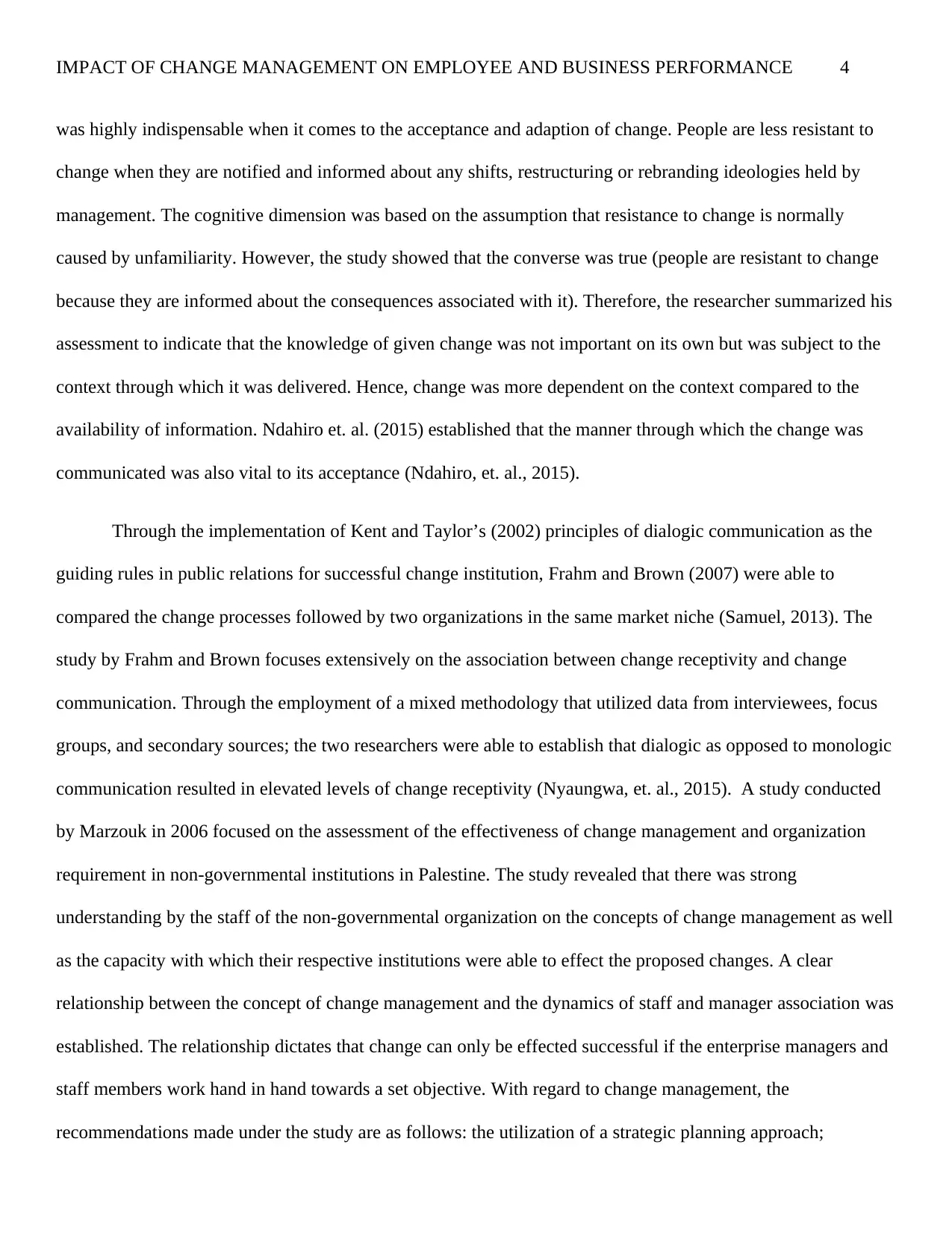
IMPACT OF CHANGE MANAGEMENT ON EMPLOYEE AND BUSINESS PERFORMANCE 4
was highly indispensable when it comes to the acceptance and adaption of change. People are less resistant to
change when they are notified and informed about any shifts, restructuring or rebranding ideologies held by
management. The cognitive dimension was based on the assumption that resistance to change is normally
caused by unfamiliarity. However, the study showed that the converse was true (people are resistant to change
because they are informed about the consequences associated with it). Therefore, the researcher summarized his
assessment to indicate that the knowledge of given change was not important on its own but was subject to the
context through which it was delivered. Hence, change was more dependent on the context compared to the
availability of information. Ndahiro et. al. (2015) established that the manner through which the change was
communicated was also vital to its acceptance (Ndahiro, et. al., 2015).
Through the implementation of Kent and Taylor’s (2002) principles of dialogic communication as the
guiding rules in public relations for successful change institution, Frahm and Brown (2007) were able to
compared the change processes followed by two organizations in the same market niche (Samuel, 2013). The
study by Frahm and Brown focuses extensively on the association between change receptivity and change
communication. Through the employment of a mixed methodology that utilized data from interviewees, focus
groups, and secondary sources; the two researchers were able to establish that dialogic as opposed to monologic
communication resulted in elevated levels of change receptivity (Nyaungwa, et. al., 2015). A study conducted
by Marzouk in 2006 focused on the assessment of the effectiveness of change management and organization
requirement in non-governmental institutions in Palestine. The study revealed that there was strong
understanding by the staff of the non-governmental organization on the concepts of change management as well
as the capacity with which their respective institutions were able to effect the proposed changes. A clear
relationship between the concept of change management and the dynamics of staff and manager association was
established. The relationship dictates that change can only be effected successful if the enterprise managers and
staff members work hand in hand towards a set objective. With regard to change management, the
recommendations made under the study are as follows: the utilization of a strategic planning approach;
was highly indispensable when it comes to the acceptance and adaption of change. People are less resistant to
change when they are notified and informed about any shifts, restructuring or rebranding ideologies held by
management. The cognitive dimension was based on the assumption that resistance to change is normally
caused by unfamiliarity. However, the study showed that the converse was true (people are resistant to change
because they are informed about the consequences associated with it). Therefore, the researcher summarized his
assessment to indicate that the knowledge of given change was not important on its own but was subject to the
context through which it was delivered. Hence, change was more dependent on the context compared to the
availability of information. Ndahiro et. al. (2015) established that the manner through which the change was
communicated was also vital to its acceptance (Ndahiro, et. al., 2015).
Through the implementation of Kent and Taylor’s (2002) principles of dialogic communication as the
guiding rules in public relations for successful change institution, Frahm and Brown (2007) were able to
compared the change processes followed by two organizations in the same market niche (Samuel, 2013). The
study by Frahm and Brown focuses extensively on the association between change receptivity and change
communication. Through the employment of a mixed methodology that utilized data from interviewees, focus
groups, and secondary sources; the two researchers were able to establish that dialogic as opposed to monologic
communication resulted in elevated levels of change receptivity (Nyaungwa, et. al., 2015). A study conducted
by Marzouk in 2006 focused on the assessment of the effectiveness of change management and organization
requirement in non-governmental institutions in Palestine. The study revealed that there was strong
understanding by the staff of the non-governmental organization on the concepts of change management as well
as the capacity with which their respective institutions were able to effect the proposed changes. A clear
relationship between the concept of change management and the dynamics of staff and manager association was
established. The relationship dictates that change can only be effected successful if the enterprise managers and
staff members work hand in hand towards a set objective. With regard to change management, the
recommendations made under the study are as follows: the utilization of a strategic planning approach;
Paraphrase This Document
Need a fresh take? Get an instant paraphrase of this document with our AI Paraphraser
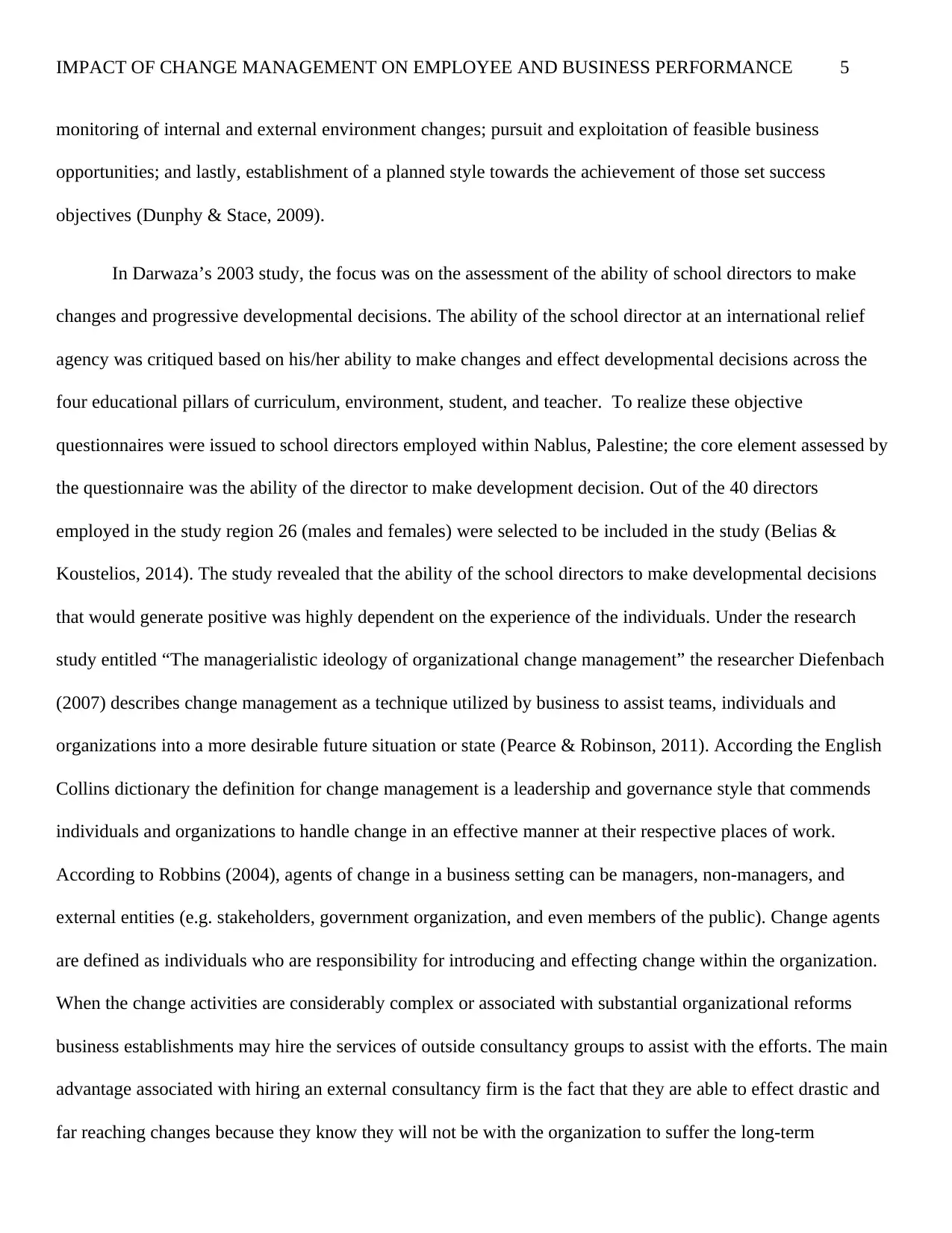
IMPACT OF CHANGE MANAGEMENT ON EMPLOYEE AND BUSINESS PERFORMANCE 5
monitoring of internal and external environment changes; pursuit and exploitation of feasible business
opportunities; and lastly, establishment of a planned style towards the achievement of those set success
objectives (Dunphy & Stace, 2009).
In Darwaza’s 2003 study, the focus was on the assessment of the ability of school directors to make
changes and progressive developmental decisions. The ability of the school director at an international relief
agency was critiqued based on his/her ability to make changes and effect developmental decisions across the
four educational pillars of curriculum, environment, student, and teacher. To realize these objective
questionnaires were issued to school directors employed within Nablus, Palestine; the core element assessed by
the questionnaire was the ability of the director to make development decision. Out of the 40 directors
employed in the study region 26 (males and females) were selected to be included in the study (Belias &
Koustelios, 2014). The study revealed that the ability of the school directors to make developmental decisions
that would generate positive was highly dependent on the experience of the individuals. Under the research
study entitled “The managerialistic ideology of organizational change management” the researcher Diefenbach
(2007) describes change management as a technique utilized by business to assist teams, individuals and
organizations into a more desirable future situation or state (Pearce & Robinson, 2011). According the English
Collins dictionary the definition for change management is a leadership and governance style that commends
individuals and organizations to handle change in an effective manner at their respective places of work.
According to Robbins (2004), agents of change in a business setting can be managers, non-managers, and
external entities (e.g. stakeholders, government organization, and even members of the public). Change agents
are defined as individuals who are responsibility for introducing and effecting change within the organization.
When the change activities are considerably complex or associated with substantial organizational reforms
business establishments may hire the services of outside consultancy groups to assist with the efforts. The main
advantage associated with hiring an external consultancy firm is the fact that they are able to effect drastic and
far reaching changes because they know they will not be with the organization to suffer the long-term
monitoring of internal and external environment changes; pursuit and exploitation of feasible business
opportunities; and lastly, establishment of a planned style towards the achievement of those set success
objectives (Dunphy & Stace, 2009).
In Darwaza’s 2003 study, the focus was on the assessment of the ability of school directors to make
changes and progressive developmental decisions. The ability of the school director at an international relief
agency was critiqued based on his/her ability to make changes and effect developmental decisions across the
four educational pillars of curriculum, environment, student, and teacher. To realize these objective
questionnaires were issued to school directors employed within Nablus, Palestine; the core element assessed by
the questionnaire was the ability of the director to make development decision. Out of the 40 directors
employed in the study region 26 (males and females) were selected to be included in the study (Belias &
Koustelios, 2014). The study revealed that the ability of the school directors to make developmental decisions
that would generate positive was highly dependent on the experience of the individuals. Under the research
study entitled “The managerialistic ideology of organizational change management” the researcher Diefenbach
(2007) describes change management as a technique utilized by business to assist teams, individuals and
organizations into a more desirable future situation or state (Pearce & Robinson, 2011). According the English
Collins dictionary the definition for change management is a leadership and governance style that commends
individuals and organizations to handle change in an effective manner at their respective places of work.
According to Robbins (2004), agents of change in a business setting can be managers, non-managers, and
external entities (e.g. stakeholders, government organization, and even members of the public). Change agents
are defined as individuals who are responsibility for introducing and effecting change within the organization.
When the change activities are considerably complex or associated with substantial organizational reforms
business establishments may hire the services of outside consultancy groups to assist with the efforts. The main
advantage associated with hiring an external consultancy firm is the fact that they are able to effect drastic and
far reaching changes because they know they will not be with the organization to suffer the long-term
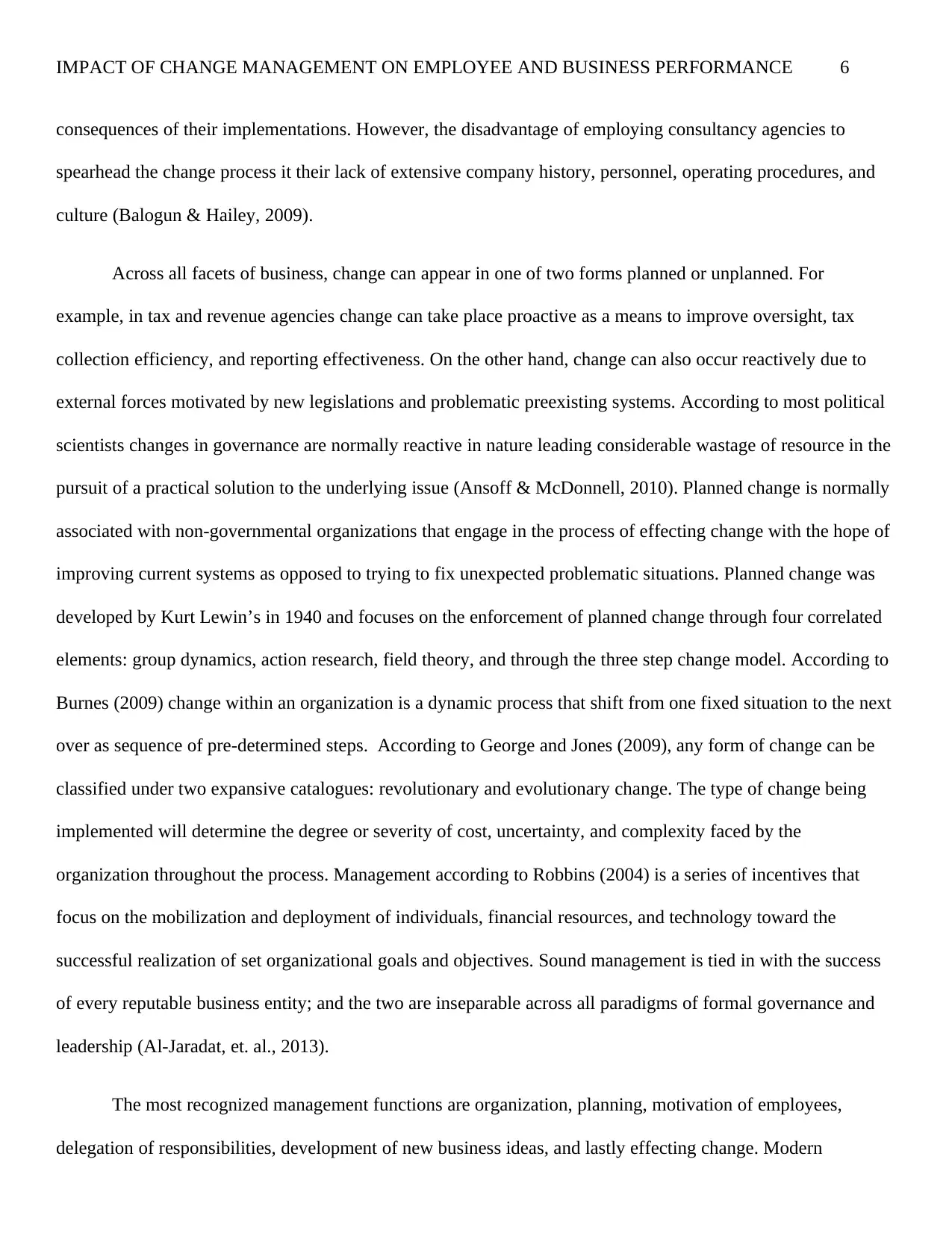
IMPACT OF CHANGE MANAGEMENT ON EMPLOYEE AND BUSINESS PERFORMANCE 6
consequences of their implementations. However, the disadvantage of employing consultancy agencies to
spearhead the change process it their lack of extensive company history, personnel, operating procedures, and
culture (Balogun & Hailey, 2009).
Across all facets of business, change can appear in one of two forms planned or unplanned. For
example, in tax and revenue agencies change can take place proactive as a means to improve oversight, tax
collection efficiency, and reporting effectiveness. On the other hand, change can also occur reactively due to
external forces motivated by new legislations and problematic preexisting systems. According to most political
scientists changes in governance are normally reactive in nature leading considerable wastage of resource in the
pursuit of a practical solution to the underlying issue (Ansoff & McDonnell, 2010). Planned change is normally
associated with non-governmental organizations that engage in the process of effecting change with the hope of
improving current systems as opposed to trying to fix unexpected problematic situations. Planned change was
developed by Kurt Lewin’s in 1940 and focuses on the enforcement of planned change through four correlated
elements: group dynamics, action research, field theory, and through the three step change model. According to
Burnes (2009) change within an organization is a dynamic process that shift from one fixed situation to the next
over as sequence of pre-determined steps. According to George and Jones (2009), any form of change can be
classified under two expansive catalogues: revolutionary and evolutionary change. The type of change being
implemented will determine the degree or severity of cost, uncertainty, and complexity faced by the
organization throughout the process. Management according to Robbins (2004) is a series of incentives that
focus on the mobilization and deployment of individuals, financial resources, and technology toward the
successful realization of set organizational goals and objectives. Sound management is tied in with the success
of every reputable business entity; and the two are inseparable across all paradigms of formal governance and
leadership (Al-Jaradat, et. al., 2013).
The most recognized management functions are organization, planning, motivation of employees,
delegation of responsibilities, development of new business ideas, and lastly effecting change. Modern
consequences of their implementations. However, the disadvantage of employing consultancy agencies to
spearhead the change process it their lack of extensive company history, personnel, operating procedures, and
culture (Balogun & Hailey, 2009).
Across all facets of business, change can appear in one of two forms planned or unplanned. For
example, in tax and revenue agencies change can take place proactive as a means to improve oversight, tax
collection efficiency, and reporting effectiveness. On the other hand, change can also occur reactively due to
external forces motivated by new legislations and problematic preexisting systems. According to most political
scientists changes in governance are normally reactive in nature leading considerable wastage of resource in the
pursuit of a practical solution to the underlying issue (Ansoff & McDonnell, 2010). Planned change is normally
associated with non-governmental organizations that engage in the process of effecting change with the hope of
improving current systems as opposed to trying to fix unexpected problematic situations. Planned change was
developed by Kurt Lewin’s in 1940 and focuses on the enforcement of planned change through four correlated
elements: group dynamics, action research, field theory, and through the three step change model. According to
Burnes (2009) change within an organization is a dynamic process that shift from one fixed situation to the next
over as sequence of pre-determined steps. According to George and Jones (2009), any form of change can be
classified under two expansive catalogues: revolutionary and evolutionary change. The type of change being
implemented will determine the degree or severity of cost, uncertainty, and complexity faced by the
organization throughout the process. Management according to Robbins (2004) is a series of incentives that
focus on the mobilization and deployment of individuals, financial resources, and technology toward the
successful realization of set organizational goals and objectives. Sound management is tied in with the success
of every reputable business entity; and the two are inseparable across all paradigms of formal governance and
leadership (Al-Jaradat, et. al., 2013).
The most recognized management functions are organization, planning, motivation of employees,
delegation of responsibilities, development of new business ideas, and lastly effecting change. Modern
⊘ This is a preview!⊘
Do you want full access?
Subscribe today to unlock all pages.

Trusted by 1+ million students worldwide
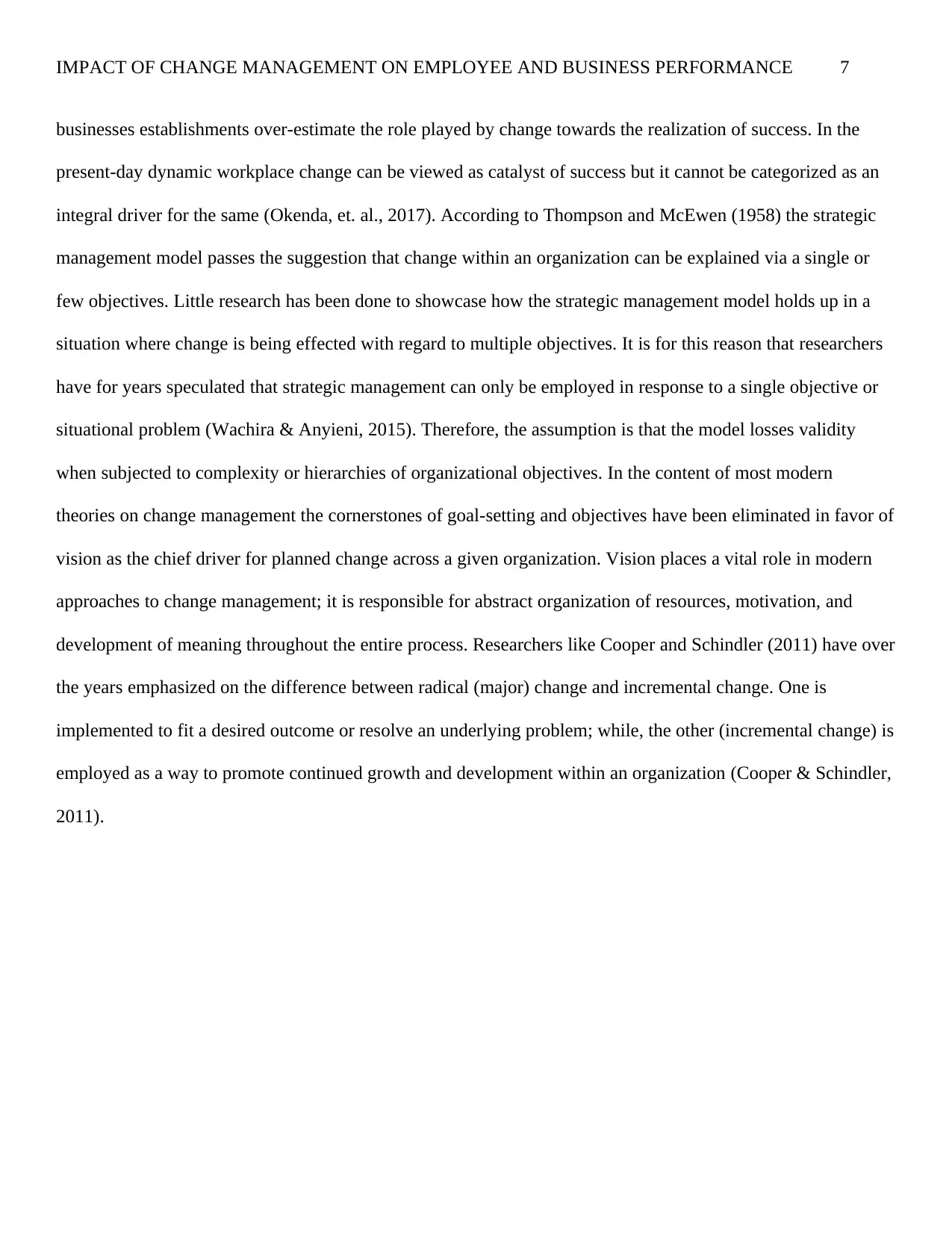
IMPACT OF CHANGE MANAGEMENT ON EMPLOYEE AND BUSINESS PERFORMANCE 7
businesses establishments over-estimate the role played by change towards the realization of success. In the
present-day dynamic workplace change can be viewed as catalyst of success but it cannot be categorized as an
integral driver for the same (Okenda, et. al., 2017). According to Thompson and McEwen (1958) the strategic
management model passes the suggestion that change within an organization can be explained via a single or
few objectives. Little research has been done to showcase how the strategic management model holds up in a
situation where change is being effected with regard to multiple objectives. It is for this reason that researchers
have for years speculated that strategic management can only be employed in response to a single objective or
situational problem (Wachira & Anyieni, 2015). Therefore, the assumption is that the model losses validity
when subjected to complexity or hierarchies of organizational objectives. In the content of most modern
theories on change management the cornerstones of goal-setting and objectives have been eliminated in favor of
vision as the chief driver for planned change across a given organization. Vision places a vital role in modern
approaches to change management; it is responsible for abstract organization of resources, motivation, and
development of meaning throughout the entire process. Researchers like Cooper and Schindler (2011) have over
the years emphasized on the difference between radical (major) change and incremental change. One is
implemented to fit a desired outcome or resolve an underlying problem; while, the other (incremental change) is
employed as a way to promote continued growth and development within an organization (Cooper & Schindler,
2011).
businesses establishments over-estimate the role played by change towards the realization of success. In the
present-day dynamic workplace change can be viewed as catalyst of success but it cannot be categorized as an
integral driver for the same (Okenda, et. al., 2017). According to Thompson and McEwen (1958) the strategic
management model passes the suggestion that change within an organization can be explained via a single or
few objectives. Little research has been done to showcase how the strategic management model holds up in a
situation where change is being effected with regard to multiple objectives. It is for this reason that researchers
have for years speculated that strategic management can only be employed in response to a single objective or
situational problem (Wachira & Anyieni, 2015). Therefore, the assumption is that the model losses validity
when subjected to complexity or hierarchies of organizational objectives. In the content of most modern
theories on change management the cornerstones of goal-setting and objectives have been eliminated in favor of
vision as the chief driver for planned change across a given organization. Vision places a vital role in modern
approaches to change management; it is responsible for abstract organization of resources, motivation, and
development of meaning throughout the entire process. Researchers like Cooper and Schindler (2011) have over
the years emphasized on the difference between radical (major) change and incremental change. One is
implemented to fit a desired outcome or resolve an underlying problem; while, the other (incremental change) is
employed as a way to promote continued growth and development within an organization (Cooper & Schindler,
2011).
Paraphrase This Document
Need a fresh take? Get an instant paraphrase of this document with our AI Paraphraser
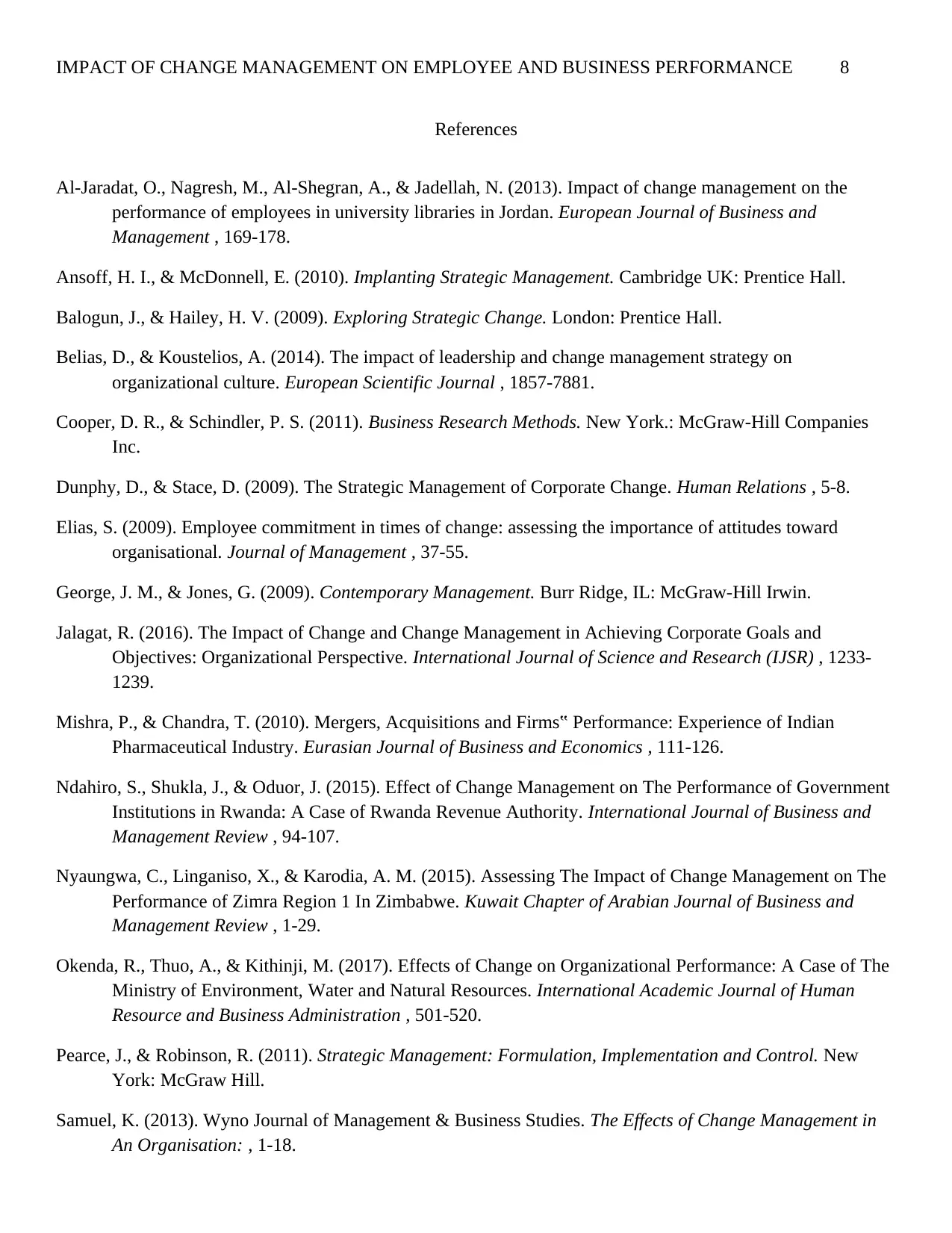
IMPACT OF CHANGE MANAGEMENT ON EMPLOYEE AND BUSINESS PERFORMANCE 8
References
Al-Jaradat, O., Nagresh, M., Al-Shegran, A., & Jadellah, N. (2013). Impact of change management on the
performance of employees in university libraries in Jordan. European Journal of Business and
Management , 169-178.
Ansoff, H. I., & McDonnell, E. (2010). Implanting Strategic Management. Cambridge UK: Prentice Hall.
Balogun, J., & Hailey, H. V. (2009). Exploring Strategic Change. London: Prentice Hall.
Belias, D., & Koustelios, A. (2014). The impact of leadership and change management strategy on
organizational culture. European Scientific Journal , 1857-7881.
Cooper, D. R., & Schindler, P. S. (2011). Business Research Methods. New York.: McGraw-Hill Companies
Inc.
Dunphy, D., & Stace, D. (2009). The Strategic Management of Corporate Change. Human Relations , 5-8.
Elias, S. (2009). Employee commitment in times of change: assessing the importance of attitudes toward
organisational. Journal of Management , 37-55.
George, J. M., & Jones, G. (2009). Contemporary Management. Burr Ridge, IL: McGraw-Hill Irwin.
Jalagat, R. (2016). The Impact of Change and Change Management in Achieving Corporate Goals and
Objectives: Organizational Perspective. International Journal of Science and Research (IJSR) , 1233-
1239.
Mishra, P., & Chandra, T. (2010). Mergers, Acquisitions and Firms‟ Performance: Experience of Indian
Pharmaceutical Industry. Eurasian Journal of Business and Economics , 111-126.
Ndahiro, S., Shukla, J., & Oduor, J. (2015). Effect of Change Management on The Performance of Government
Institutions in Rwanda: A Case of Rwanda Revenue Authority. International Journal of Business and
Management Review , 94-107.
Nyaungwa, C., Linganiso, X., & Karodia, A. M. (2015). Assessing The Impact of Change Management on The
Performance of Zimra Region 1 In Zimbabwe. Kuwait Chapter of Arabian Journal of Business and
Management Review , 1-29.
Okenda, R., Thuo, A., & Kithinji, M. (2017). Effects of Change on Organizational Performance: A Case of The
Ministry of Environment, Water and Natural Resources. International Academic Journal of Human
Resource and Business Administration , 501-520.
Pearce, J., & Robinson, R. (2011). Strategic Management: Formulation, Implementation and Control. New
York: McGraw Hill.
Samuel, K. (2013). Wyno Journal of Management & Business Studies. The Effects of Change Management in
An Organisation: , 1-18.
References
Al-Jaradat, O., Nagresh, M., Al-Shegran, A., & Jadellah, N. (2013). Impact of change management on the
performance of employees in university libraries in Jordan. European Journal of Business and
Management , 169-178.
Ansoff, H. I., & McDonnell, E. (2010). Implanting Strategic Management. Cambridge UK: Prentice Hall.
Balogun, J., & Hailey, H. V. (2009). Exploring Strategic Change. London: Prentice Hall.
Belias, D., & Koustelios, A. (2014). The impact of leadership and change management strategy on
organizational culture. European Scientific Journal , 1857-7881.
Cooper, D. R., & Schindler, P. S. (2011). Business Research Methods. New York.: McGraw-Hill Companies
Inc.
Dunphy, D., & Stace, D. (2009). The Strategic Management of Corporate Change. Human Relations , 5-8.
Elias, S. (2009). Employee commitment in times of change: assessing the importance of attitudes toward
organisational. Journal of Management , 37-55.
George, J. M., & Jones, G. (2009). Contemporary Management. Burr Ridge, IL: McGraw-Hill Irwin.
Jalagat, R. (2016). The Impact of Change and Change Management in Achieving Corporate Goals and
Objectives: Organizational Perspective. International Journal of Science and Research (IJSR) , 1233-
1239.
Mishra, P., & Chandra, T. (2010). Mergers, Acquisitions and Firms‟ Performance: Experience of Indian
Pharmaceutical Industry. Eurasian Journal of Business and Economics , 111-126.
Ndahiro, S., Shukla, J., & Oduor, J. (2015). Effect of Change Management on The Performance of Government
Institutions in Rwanda: A Case of Rwanda Revenue Authority. International Journal of Business and
Management Review , 94-107.
Nyaungwa, C., Linganiso, X., & Karodia, A. M. (2015). Assessing The Impact of Change Management on The
Performance of Zimra Region 1 In Zimbabwe. Kuwait Chapter of Arabian Journal of Business and
Management Review , 1-29.
Okenda, R., Thuo, A., & Kithinji, M. (2017). Effects of Change on Organizational Performance: A Case of The
Ministry of Environment, Water and Natural Resources. International Academic Journal of Human
Resource and Business Administration , 501-520.
Pearce, J., & Robinson, R. (2011). Strategic Management: Formulation, Implementation and Control. New
York: McGraw Hill.
Samuel, K. (2013). Wyno Journal of Management & Business Studies. The Effects of Change Management in
An Organisation: , 1-18.
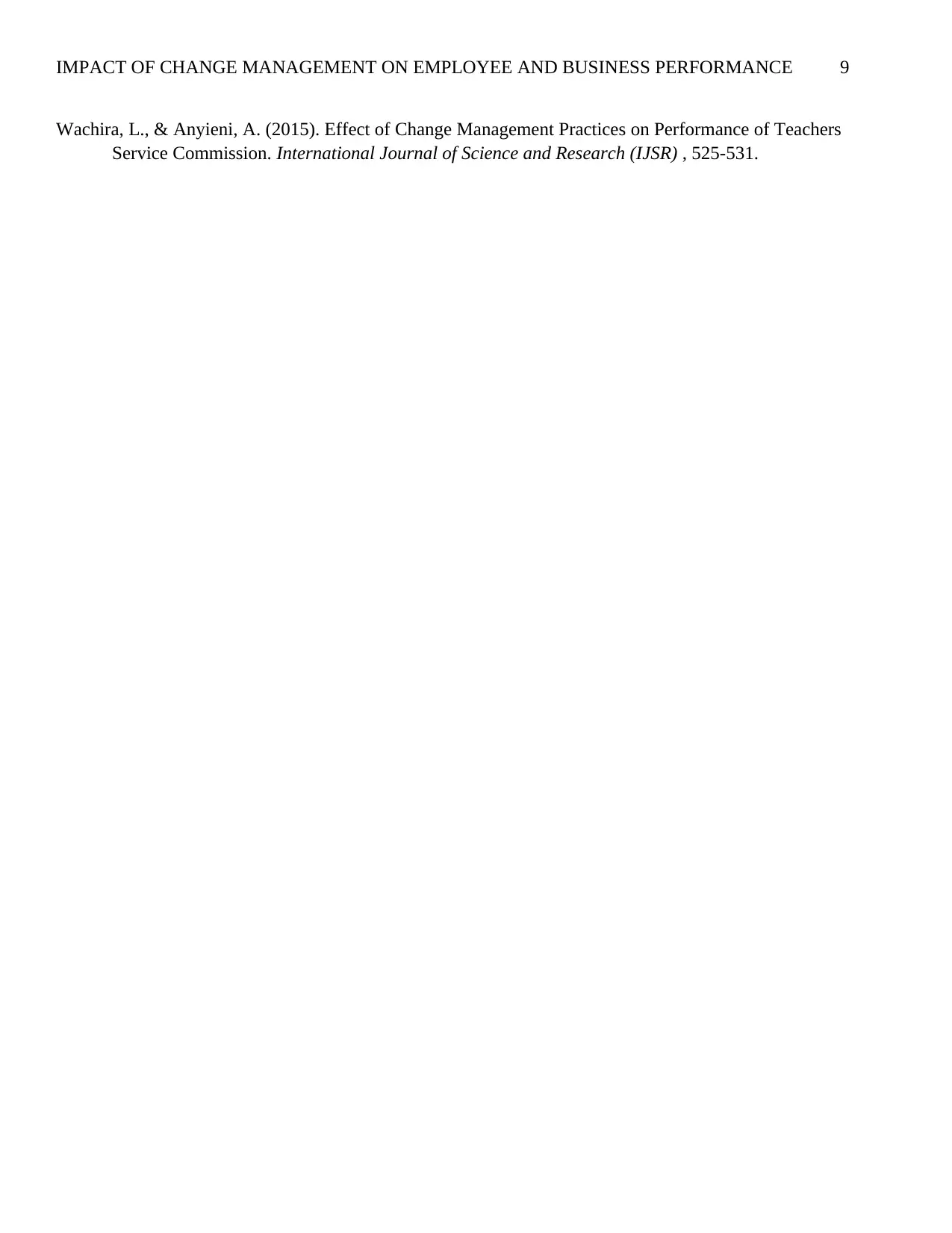
IMPACT OF CHANGE MANAGEMENT ON EMPLOYEE AND BUSINESS PERFORMANCE 9
Wachira, L., & Anyieni, A. (2015). Effect of Change Management Practices on Performance of Teachers
Service Commission. International Journal of Science and Research (IJSR) , 525-531.
Wachira, L., & Anyieni, A. (2015). Effect of Change Management Practices on Performance of Teachers
Service Commission. International Journal of Science and Research (IJSR) , 525-531.
⊘ This is a preview!⊘
Do you want full access?
Subscribe today to unlock all pages.

Trusted by 1+ million students worldwide
1 out of 9
Related Documents
Your All-in-One AI-Powered Toolkit for Academic Success.
+13062052269
info@desklib.com
Available 24*7 on WhatsApp / Email
![[object Object]](/_next/static/media/star-bottom.7253800d.svg)
Unlock your academic potential
Copyright © 2020–2025 A2Z Services. All Rights Reserved. Developed and managed by ZUCOL.



